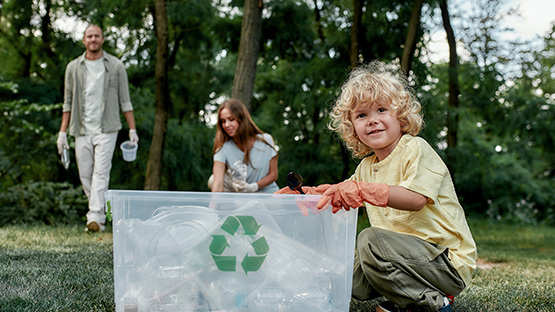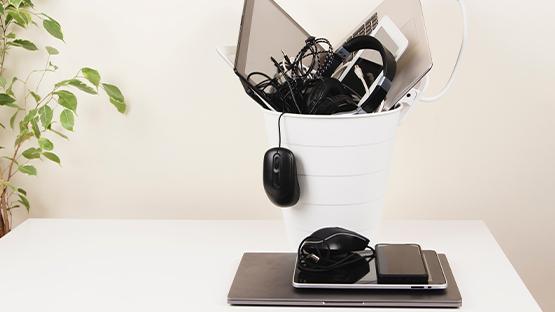Battery recycling - how is it done and why is it important?
Ekologia

24 January 2023
Batteries are devices that you may often use completely unaware of. The facts are that batteries surround you, you use them and they are a huge convenience. However, have you wondered what battery recycling is all about? This process is extremely important for safety and environmental protection, and the more people know about it, the easier it will be to ensure that batteries are reused.
Battery recycling - how does it happen?
A rechargeable battery is a type of battery that is rechargeable with electricity to operate other mechanisms and machines with stored energy. Rechargeable batteries are ubiquitous in everyday use - from small batteries in toys, to car batteries, batteries in laptops and phones. Each battery has a certain possible number of charges, after which it may cease to function properly.
Therefore, batteries need to be disposed of properly, as some components may be reusable and their construction can result in the device becoming an environmental bomb without proper care. What does battery recycling look like?
Regulations clearly prohibit the disposal of batteries in a landfill, hence the best solution is to recycle the battery. Smaller batteries are collected, for example, in special containers in various public places. They are then segregated, after which they undergo various processes, such as: mechanical separation, chemical separation and smelting. With these processes, reusable raw materials can be recovered from batteries. The most commonly used battery recycling technology in Poland is thermal recycling.
If you have a large battery, take it to one of the waste disposal centres or see if there is a mobile collection point for problematic waste in your town.
What should you know before recycling batteries?
Recycling batteries is an extremely important process because of the inside of the device. Due to their heavy metal content, if left to decompose they could be a hazard. In addition, it would be a huge waste - the raw materials are to some extent recoverable and reusable, and besides, they belong to rare raw materials, i.e. those with small deposits on Earth.
Battery recycling - harmful substances in batteries?
Although batteries may look inconspicuous, an ordinary 'fingertip' is capable of permanently contaminating 1 m3 of land or poisoning nearly 400 litres of water. It is hard to imagine how much greater the damage caused by larger batteries would be.
The greatest responsibility for such a destructive impact on the environment lies with heavy metals such as mercury, nickel, lithium, cadmium, cobalt or carbon dioxide. The toxic elements are locked inside the battery, filled with electrolytes, and do their job. As with everything, the outer shell is also subject to decomposition and the effects of external agents, hence the so-called battery spill can sometimes be encountered. This is a situation in which hazardous substances escape. The metals required to make batteries are toxic, and the electrolyte that fills them is corrosive, plus it can cause corrosion.
The most damaging variety of batteries are lead-acid batteries, due to their high heavy metal content (this is the type of cell used in cars) and acid filling. 
How does the battery recycling process work?
Recycling of batteries can take place in several ways, depending on the type of battery and its size. Once batteries have been collected and sorted, they can go several ways.
The first and most popular is thermal treatment, to melt down and reuse individual battery components. This is the process that is used to recycle lithium and lithium-ion batteries.
Another is hydrometallurgical recycling, otherwise known as chemical separation. The battery is placed in acid, in which the waste is dissolved and the remaining parts are not decomposed and are reused.
Mechanical separation is the grinding of the battery in a special mill, followed by the separation of plastic, paper and recyclable waste.
What can be recovered from old batteries?
Among the valuable materials that can be recovered from batteries, the heavy metals lithium, nickel, cobalt, manganese or graphite are mainly mentioned. It is also worth mentioning the plastic and aluminium components that are recovered from larger batteries, for example during their processing and recycling of car batteries and from electric cars.
The recycling of lead-acid batteries is extremely important, due to their level of harm and often inefficient methods of recovering raw materials. For this type of battery, the process of smelting the raw materials is inefficient and the resulting materials are not reusable. The NUOVO project proposed by the EU allows lead oxide to be separated from the product, ready for use in a new battery.
In addition, the Association of Producers and Importers of Batteries and Accumulators in Poland has had a strong influence on the appearance of the current law and the degree of recycling of batteries. SPIAB brings together entrepreneurs supplying lead-acid batteries to the Polish market to control what happens to the products from distribution to user consumption. The association's activities have led to a situation where almost 100% of the battery is recycled, which is an impressive result compared to more commonly recycled items.
Battery recycling - where to recycle a used battery?
Battery recycling starts with returning the device to the right place so that it can be recycled as semi-finished or new batteries. Contrary to what you might think, the collection of items is often unnoticed and can be found in places you frequent regularly, such as shops, shopping malls or service outlets. This is especially true for small batteries that power household appliances, but as you know, even these can be hazardous to the environment without proper disposal. If you are still in doubt about where to hand in your discharged batteries, there are several options.
If you have batteries at home that are no longer usable, check where your nearest drop-off point is. Electrical waste points usually resemble vending machines, and you can also throw CDs, light bulbs or phones and chargers into them. Bins in schools or shops look like large batteries, decorated with recycling information. You don't have to determine what type of battery they are, they can all go in one bin. The procedure for accurately sorting and analysing whether a battery can be used lies with the recyclers.
Larger appliances, such as vehicle batteries or those powering boats, photovoltaics, campervans and even wheelchairs, can cause more problems. You can easily take such power supplies to your local municipal waste collection point. In addition to heading to such a location, you can also use the services of the PSZOK on a mobile basis - sometimes collections take place with the point's container appearing at various locations in the municipality.
You can find the addresses of PSZOKs by entering "PSZOK" and the name of the locality into an Internet search engine. Your local council should also be able to provide you with this information. If you take your battery to a collection point, you can be sure that it will end up in the right place, because this is what the PSZOKs do. Reusable waste goes to recyclers, who allow the batteries to be recycled again.
This is not the only way to dispose of larger power packs properly. Most of them should be collected free of charge by shops whose offer provides for the collection of the old battery when buying a new one. As for car batteries, in addition to returning them to the PSZOK, they can be donated to SPIAB.
How does battery recycling help protect the environment?
The existence of a second circuit allows seemingly 'disposable' things to be reused in more than just the form in which they were originally produced. This is a great merit of recycling, whereby even complex equipment can be reused. This is particularly important when it comes to items with hazardous compositions or manufactured with rare ingredients. These include batteries.
For this reason, their recycling is necessary to protect the environment. Even small batteries can wreak havoc due to their filling, essential for the operation of the device. This makes it all the more important to raise public awareness of the need for proper disposal and segregation of this type of waste. Not only does this benefit the environment, it also helps to protect it on several levels.
The first is that harmful substances from heavy metals, acids and electrolytes that could leach from a leaking battery into a landfill or, worse, a forest, are not released into the environment. In addition, harmful substances may find a better use than pissing into the ground. Many of these are heavy metals that can be reused in industry, are elements in household appliances due to their properties and are an essential part of battery production. They are usually rare metals, so exploiting what is already on the market could significantly reduce the cost of extracting them, as well as exploring the earth for them.
Rechargeable batteries are remarkable devices that have streamlined many processes and allowed far greater mobility. Only by using them wisely will they last a long time and not cause damage when they become useless to consumers and essential to the second circuit.
Czytaj również

Where to donate your clothes? Give them a second life together with InPost!
Where to donate clothes you no longer wear? Instead of throwing away good clothes, it is worth donating them to others for further use. Do...

Where to donate toys you no longer need? We have a good way to do it!
Quite a few children have rooms full of toys. They receive more gadgets from grandparents, parents or aunts and uncles. Sometimes the obje...




